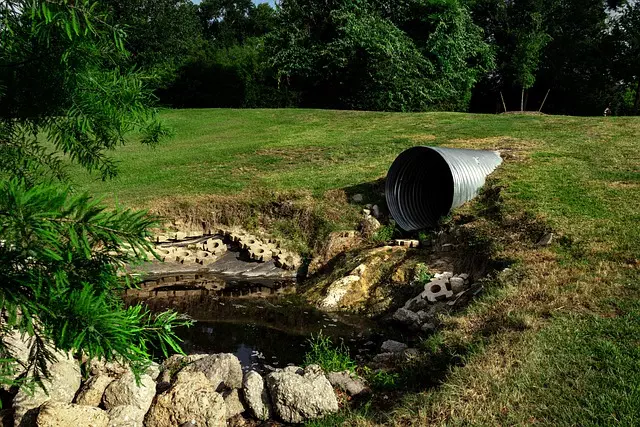In Toledo, fast sewer line excavation services prioritize safety and efficiency using specialized Sewer Line Excavation Tools like mechanical excavators and hydro-excavators. This approach, combined with best practices for Sewer Line Repair, involves strategic planning, precise excavation, and robust safety measures to prevent cave-ins, gas exposure, and electrical hazards. By adhering to these protocols, professionals ensure minimal damage, reduced costs, and a reliable restoration of underground infrastructure.
In the realm of infrastructure maintenance, sewer line trenches are a vital yet potentially hazardous component. Navigating these challenges demands meticulous planning and adherence to safety protocols. This article illuminates the critical aspects of sewer line trench safety, offering insights into managing risks and ensuring seamless operations. We explore essential tools for efficient fast sewer line excavation services in Toledo, strategies for safe sewer line repair, and best practices to safeguard workers during projects, emphasizing the importance of thorough preparation and adherence to standards, particularly when employing advanced techniques like quick sewer line excavation.
- Understanding Sewer Line Trench Safety: Risks and Precautions
- Essential Tools for Efficient Fast Sewer Line Excavation Services in Toledo
- Strategies for Safe Sewer Line Repair: A Step-by-Step Guide
- Best Practices to Ensure Trench Safety During Sewer Line Projects
Understanding Sewer Line Trench Safety: Risks and Precautions
Understanding Sewer Line Trench Safety: Risks and Precautions
When it comes to sewer line repair or installation, trench safety is paramount. The process involves fast sewer line excavation services in Toledo, which can present significant risks if not handled properly. Specialized tools and techniques are employed for efficient excavation while minimizing hazards. One of the primary concerns is ensuring worker safety within deep trenches, where a single misstep could lead to severe injuries or fatalities.
Proper precautions include implementing guardrails, using safe entry and exit points, and maintaining adequate lighting in trench environments. Regular inspections and adherence to local safety regulations are essential for all fast sewer line excavation services. These measures help prevent cave-ins, expose workers to toxic gases, or mitigate the risk of electrical hazards often present in underground infrastructure.
Essential Tools for Efficient Fast Sewer Line Excavation Services in Toledo
When it comes to efficient sewer line excavation in Toledo, having the right tools is paramount. Fast Sewer Line Excavation Services Toledo experts rely on specialized equipment designed for precision and speed when repairing or replacing underground pipes. These include advanced excavation machines equipped with GPS technology for accurate cutting and clearing of soil around the sewer lines without causing damage.
In addition to machinery, hand tools like shovels, pry bars, and hydraulic cutters are essential for navigating tight spaces, handling smaller repair jobs, and ensuring minimal disruption to the surrounding area. The use of these specialized Sewer Line Excavation Tools not only expedites the process but also minimizes the risk of leaks or other complications during sewer line repair or replacement, offering a more reliable and cost-effective solution for Toledo residents and businesses.
Strategies for Safe Sewer Line Repair: A Step-by-Step Guide
When it comes to repairing sewer lines, safety is paramount. A well-planned and executed strategy ensures minimal disruption to surrounding areas and reduces risks for workers. Here’s a step-by-step guide on navigating this process efficiently, especially when utilizing fast sewer line excavation services in Toledo:
1. Assessment: Begin by assessing the extent of the damage. This determines the repair method—patching, relining, or complete replacement. Modern tools like hydraulic hammers and advanced sewer cameras aid in accurate evaluation.
2. Planning: Once the repair type is identified, develop a detailed plan. This involves setting aside access points, coordinating with local authorities for utility locates, and arranging traffic control if needed. Fast excavation services can expedite this stage by providing efficient and precise trenching.
3. Excavation: Employ specialized equipment like backhoes and sewer line excavation tools to create a trench of the required depth and length. Safety measures must be in place, including protective gear for workers, clear signage, and lighting if work extends into the night.
4. Repair Execution: Implement the chosen repair method. Relining involves inserting a new pipe within the old one, while complete replacement entails removing the damaged section and installing a new segment. Throughout this process, ensure proper backfilling to maintain soil stability.
5. Inspection and Testing: After completion, inspect the repaired area for any signs of weakness or leaks. Modern leak detection technologies can aid in this step. Once verified safe, the trench is backfilled, and the surface restored, ready for traffic and normal usage.
Best Practices to Ensure Trench Safety During Sewer Line Projects
When undertaking sewer line projects involving trench excavation in Toledo, adhering to best practices is paramount to ensure safety for workers and prevent environmental hazards. Fast Sewer Line Excavation Services Toledo professionals emphasize the use of specialized tools designed for precise and efficient digging, minimizing the risk of damage to existing infrastructure. These include advanced mechanical excavators, hydro-excavators (also known as vacuum excavators), and hand tools tailored for intricate tasks.
Implementing robust safety protocols is another critical aspect. This involves training workers in safe excavation practices, setting up clear communication channels, and regularly inspecting trench walls for instability. Adequate shielding, guardrails, and protective gear are essential to safeguard against falling debris and moving equipment. Regular monitoring of air quality inside the trench also ensures the well-being of workers during extended periods underground, preventing health risks associated with confined spaces.


